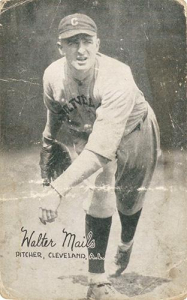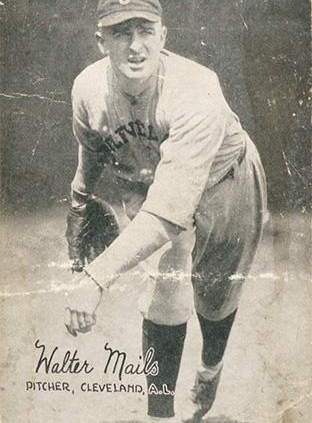September 24, 1920: Duster Mails outduels Red Faber as Cleveland increases lead amid fix rumors
 The September 24, 1920, edition of the Akron Beacon Journal blared the following headline across its sports section: “Ban Johnson Called to Stand Today; Tell Plot Against Chicago.” Johnson, the American League president, was testifying before a Cook County (Chicago) grand jury about a plot to blackmail Chicago White Sox players.
The September 24, 1920, edition of the Akron Beacon Journal blared the following headline across its sports section: “Ban Johnson Called to Stand Today; Tell Plot Against Chicago.” Johnson, the American League president, was testifying before a Cook County (Chicago) grand jury about a plot to blackmail Chicago White Sox players.
Johnson predicted that the White Sox, narrowly trailing the first-place Cleveland Indians in the AL standings, would not “dare to win the pennant in 1920.” Johnson explained that the gambling syndicate that allegedly paid certain White Sox players for throwing the 1919 World Series was threatening those same players with exposure should they win the flag in 1920.1
At the heart of the matter was New York Giants pitcher Rube Benton, who claimed to have knowledge that a Pittsburgh gambling syndicate paid certain White Sox players $100,000 to throw the series. Benton named Chicago’s Eddie Cicotte, Lefty Williams, Happy Felsch, Chick Gandil, and one other player whose name he couldn’t recall. Benton was ready to share this information with the grand jury.2
It was amazing that the White Sox team, with the season bubbling to a boiling point, was in the thick of the American League pennant race. On September 22, Chicago (91-55) trailed first-place Cleveland (91-52) by 1½ games. The teams began a three-game series in Cleveland on September 23, the day before Johnson testified in Chicago. The White Sox had only five games remaining on their schedule after the Cleveland series. It was imperative that they take two of three games from the Tribe – at the very least. This was the last series between the two teams in 1920, with the Indians holding an 11-8 advantage entering the series.
In the opener, the White Sox cut the gap to a half-game by pummeling the Indians, 10-3. Cleveland starter Jim Bagby Sr. was going for his 30th win of the season, but the White Sox hitters would have none of it. Except for Buck Weaver, every Chicago player scored at least one run. Amos Strunk and Felsch each knocked in two runs. Chicago battered Indians pitching for 15 hits, three each by Felsch and Joe Jackson. Chicago starter Dickey Kerr (19-9) scattered eight hits, giving up two earned runs in the complete-game victory.
Game Two was set for the next afternoon at Dunn Field. Right-hander Red Faber (23-11, 2.86 ERA) started for Chicago, opposing lefty Walter Mails (5-0, 2.13 ERA). Faber had won three games in the 1917 World Series but battled arm and ankle injuries throughout 1919, which caused him to miss the World Series that season.
Cleveland had acquired the 25-year-old Mails, who had debuted in the majors with 13 appearances with the Brooklyn Robins in 1915 and 1916, from Sacramento of the Pacific Coast League on August 21, 1920. Nicknamed Duster for his wildness while hurling, he did not suffer from a lack of confidence in his abilities. “This afternoon’s game is won right now,” Mails said before the game. “Some of those fellows are going to be lucky to get a foul off me. I’ll be the most surprised man in Cleveland if I don’t shut them out.”3
Cleveland opened the scoring in the bottom of the first inning. Charlie Jamieson reached on an infield single. He took second on a sacrifice by Bill Wambsganss. After a groundout by Tris Speaker, Jamieson scored on a two-out single by Elmer Smith.
The Indians tacked on a second run in the bottom of the second frame. Shortstop Joe Sewell, appearing in only his 13th big-league game after stepping in for the fatally injured Ray Chapman,4 hit a ball toward second base and beat second sacker Eddie Collins’s throw to first. The 21-year-old Sewell, whose two hits in this game pushed his batting average to .381, stole second and scored on a single to center field by Steve O’Neill.
The Indians led 2-0 and were in position for another run after Mails sacrificed O’Neill to second base. Jamieson singled to right field, sending O’Neill to third. But Jamieson overran first base and was caught in a rundown between first and second. During the rundown, O’Neill strayed too far from the bag at third and was out on a throw to third baseman Buck Weaver.
The “Great Mails,” as he preferred to be called, was living up to his prognostication. Through four innings he shut out the White Sox. In the top of the fourth inning, Chicago got singles from Eddie Collins and Felsch, but the threat was ended when Shano Collins’s liner to shortstop was turned into an unassisted double play.
The top of the fifth inning started with Mails whiffing Swede Risberg. Then Mails’ wildness came to light when he walked Ray Schalk, Faber, and Strunk, loading the bases. Cleveland manager Tris Speaker strolled to the mound from his center-field position. “You are not getting your side-arm ball over,” said Speaker. “Stick it in your pocket until the inning is over and use your overhand ball.”5
Heeding the skipper’s advice, Mails bore down and struck out Buck Weaver and Eddie Collins to leave the bases loaded. The crowd roared with delight after Mails struck out Collins. “It was such a din that the Indians as they joyfully came rushing in from the field were forced to put their fingers to their ears to save their eardrums from being shattered by volume of the demonstrative uproar as it swept out of the stands,” reported the Cleveland Plain Dealer.6
After a one-out walk to Felsch in the top of the sixth inning, Mails retired the next 11 White Sox batters. Likewise, Cleveland could not score another run off Faber. The game ended in a 2-0 victory for Cleveland. Chicago slipped back to 1½ games behind the Indians.
Mails gave up three hits, struck out six, and walked five to improve his record to 6-0. Faber also went the distance, surrendering two earned runs on nine hits, striking out one, and walking none.
“I never saw a ball take a sharper hop than Mails’ fast one did today,” said home-plate umpire Brick Owens.7
The White Sox won the third game of the series, 5-1, behind Williams. The third game drew an overflow crowd of 33,000 spectators. For the series, the attendance slightly exceeded 75,000 fans.
After the third game, Chicago headed home to meet the Detroit Tigers in a two-game series. The White Sox swept the Tigers. Cleveland also hit the rails and faced the St. Louis Browns in a four-game set. Cleveland swept the Browns. They now led the White Sox by 1½ games as September ended. Each team was on the road to finish the season: Cleveland at Detroit for four games and Chicago at St. Louis for three.
But the hammer came down on September 28, 1920, when Eddie Cicotte and Joe Jackson testified before the grand jury and admitted their involvement in the World Series fix. The Cook County grand jury later indicted eight White Sox players for conspiring to throw the 1919 World Series. White Sox owner Charles Comiskey immediately suspended seven of the players; an eighth, Chick Gandil, had already retired from baseball.
The Indians and Tigers split four games while the Browns took two of three from Chicago. Cleveland won the AL pennant, edging out Chicago by two games.
There were also allegations that some of the White Sox players had thrown games during the 1920 season. One of the games in question was the game on September 24 at Cleveland. An unnamed umpire, possibly Ollie Chill, who was the base umpire that day, said, “Mails pitched for Cleveland, and he didn’t have a thing. But the Sox players didn’t hit him and the Indians won the game.”8 Nonetheless, this statement contradicts what plate umpire Owens said about Mails’ stuff that day.
There are some who will claim that the suspensions handed the flag to Cleveland. But Black Sox historian Jacob Pomrenke disputes this charge. “The idea that the White Sox were a shoo-in to win the AL pennant in 1920 doesn’t match reality,” wrote Pomrenke.
“The last day the White Sox held a share of first place was September 10, but Chicago had been consistently 3-5 games behind Cleveland for most of the season. The final three weeks were neck-and-neck, and the Sox won 10 of 11 games in mid-September (including two of three at Cleveland on September 23-25) to remain close. But Cleveland was just as good down the stretch. Regardless of how hard the Sox were actually trying to win, they still needed help from Detroit or St. Louis in the final week in order to leapfrog into first place. They didn’t get that help.”9
Cleveland went on to win its first World Series, beating the Brooklyn Robins five games to two in the best-of-nine series. Mails started Game Six and shut out the Robins, 1-0. His career went downhill from there. In seven seasons, Mails compiled a 32-25 record and a 4.10 ERA.
Acknowledgments
The author would like to thank SABR member Jacob Pomrenke for his help with this story. This article was fact-checked by Larry DeFillipo and copy-edited by Len Levin.
Sources
In addition to the sources cited in the Notes, the author consulted the Baseball-Reference.com, Stathead.com, and Retrosheet.org websites for pertinent materials and the box scores.
https://retrosheet.org/boxesetc/1920/B09240CLE1920.htm
https://www.baseball-reference.com/boxes/CLE/CLE192009240.shtml
Notes
1 “Ban Johnson Called to Stand Today; Tell Plot Against Chicago,” Akron Beacon Journal, September 24, 1920: 24.
2 “Ban Johnson Called to Stand Today.”
3 Henry P. Edwards, “Game Today Last of League Season Here,” Cleveland Plain Dealer, September 25, 1920: 18.
4 Harry Lunte had originally replaced Chapman at shortstop. After Lunte suffered an injury, Cleveland purchased Sewell from New Orleans of the Southern Association.
5 “Game Today Last of League Season Here.”
6 Henry P. Edwards, “Indians Turn Back White Sox in Great 2-0 Battle,” Cleveland Plain Dealer, September 25, 1920: 18.
7 Edwards, “Game Today Last of League Season Here.”
8 “Umpires Say Sox ‘Threw’ 1920 Pennant,” Washington Times, September 30, 1920: 1.
9 Email exchange with Jacob Pomrenke, February 1, 2023.
Additional Stats
Cleveland Indians 2
Chicago White Sox 0
Dunn Field
Cleveland, OH
Box Score + PBP:
Corrections? Additions?
If you can help us improve this game story, contact us.


